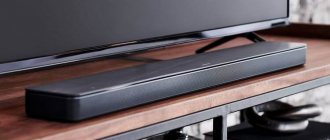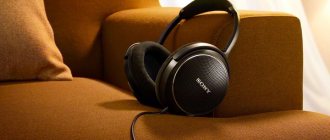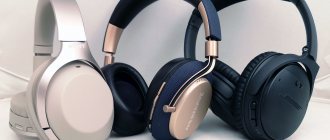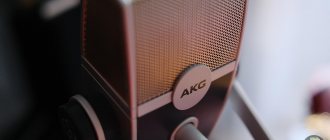Sound as a physical phenomenon is elastic waves of mechanical vibrations that propagate in any medium - liquid, solid or gaseous. Any wave, including sound, has two characteristics: amplitude and frequency. The latter represents the number of repetitions of a periodic process (in this case, oscillations) per unit of time. To measure frequency, there is a special unit - hertz (Hz), indicating the number of vibrations per second. 1 Hz is one oscillation per second.
Frequencies with a small number of oscillations per unit of time are called low, and those with a large number are called high.
A little theory
Sound is the propagation of mechanical vibrations in a gaseous or liquid medium. Like any wave, sound has parameters such as amplitude (characterizes volume) and frequency (characterizes tonality).
The average person's ear is capable of detecting sound with frequencies ranging from 16-20 Hz to 15-20 kHz. In turn, this range has three “steps”:
- 20-150 Hz – low frequencies.
- 150-7000 Hz – mid frequencies.
- 7-20 kHz – high frequencies.
The higher the vibration frequency, the higher the pitch of the sound. For example, a bumblebee, which flaps its wings slowly, hums, and a mosquito, the frequency of whose wings flapping is significantly higher, squeaks vilely, hiding in the darkness.
Sound below the audibility range is called infrasound, from 20 kHz ultrasound. The human ear does not perceive them, but such sounds with a large amplitude can have an effect on the body.
This range is fully perceived by a person with perfect pitch. In conditions of constant background noise, the ability to perceive the entire spectrum of frequencies deteriorates over time.
In addition, with age, almost every person is susceptible to senile hearing loss, when high-frequency sound is not perceived.
Biologically, it is determined that women perceive high frequencies better, and also better distinguish intonations and tones, which is influenced by the need to care for offspring.
For the same reason, most of the fair sex are difficult to deceive - they are able to detect any falsehood in the voice. It is also worth noting that in women, hearing begins to deteriorate by the age of 40, while in men this process starts at 30.
In relation to speakers, the sounds of human speech and music are primarily of interest. There are significantly fewer aesthetes who listen to the sounds of wildlife on the computer compared to film buffs and music lovers.
Audiofilkin's certificate: about the frequency range, age, vinyl and frequency response of Pink Floyd cymbals
In the comments, not for the first time, I came across the argument that the uniformity of the frequency response above 16 kHz is almost the most important parameter for fidelity of reproduction. At least very, very significant. I often encounter similar opinions from people who are over thirty years old, and sometimes over forty. And, as a rule, the same people claim that the frequency range of vinyl recordings is supposedly higher than that of CDDA (as well as the fidelity of playback). They absolutely categorically declare that they not only hear up to 20 kHz (and sometimes higher), but also provide spectrograms where the beloved Nick Mason (drums of the golden lineup of Pink Floyd) allegedly extracts these same 20 + kHz from his cymbals.
When you try to explain to people in the comments that they persist in delusion, stories begin that they are great practitioners, they saw everything on the spectrogram, you cannot deceive them with “theoretical dregs.” Due to my education, I am familiar with the physiology of hearing, and due to my hobbies, I am familiar with the practice of sound recording. Below the cut, I will try to explain in detail why the stories about “20 kHz in Pink Floyd’s cymbals,” the magical range of vinyl recordings and the ability to hear 20 kHz after 30 years have nothing to do with reality.
Let's start with hearing capabilities and age-related loss
Everyone knows that a person is capable of hearing in the range from 20 Hz (according to other sources, from 16) to 20 kHz (according to other sources, up to 21 kHz). At the same time, many people forget that this range decreases over time, and the older a person gets, the lower his threshold for sensing high frequencies. Otolaryngologists, in particular audiologists, believe that a ceiling of 8000 Hz is the norm and allows a person to live a normal life (I, of course, would clarify that audiophiles cannot, but audiologists write that 8 kHz is enough). The same audiologists often use a simplified age table that roughly describes hearing loss with age:
- up to 19000 Hz - under 20 years.
- up to 17000 Hz - under 24 years old,
- up to 16000 Hz - under 30 years old,
- up to 15000 Hz - under 40 years old,
- up to 12000 Hz - under 50 years old,
- up to 8000 Hz everyone should hear.
These data are quite conditional. For example, I am 35 years old and I hear 17500 Hz, and someone at my age can hardly distinguish 15.5 kHz, and at 16 they can no longer hear anything. On average, 16 kHz is considered the average threshold value for most people. Almost everyone relies on this frequency, including sound engineers. But there are also individual characteristics, such as its own frequency response.
Psychoacoustic experiments demonstrate that people do not hear the same way, and there are individual differences in frequency perception. Sometimes the range can be limited to a frequency of 15 kHz, he does not hear everything higher, but is able, for example, to selectively hear sounds with a frequency of 18.5 kHz. I have not come across an exact explanation for such a phenomenon, but the fact is that it is described and exists.
The intensity of age-related hearing loss depends on a number of factors, and, perhaps, the main one is regular exposure to noise, as well as loud sounds, injuries, and inflammation. Hearing degradation in modern conditions occurs to one degree or another in everyone (at least if we talk about city residents), since regular noise exposure affects the ciliated cells of the cochlea.
In addition to noise, inflammatory and traumatic damage, A. Saxen and N. Fiand established other common causes of natural age-related hearing degradation (presbycusis). Let's highlight two main ones. The first is a disruption of the blood supply to the cochlear labyrinth as a result of ischemia (narrowing of the lumen of the blood vessels supplying the cochlea); circulatory disturbances can also be caused by changes in the rheological properties of the blood (including thrombosis), atherosclerosis and other vascular diseases.
As a result of such disorders, the hair cells of the cochlea (auditory receptors) experience oxygen starvation, and the function of the receptors is impaired. Sometimes local cell death occurs - necrosis, which leads to significant hearing loss. But more often, the correct transformation of sounds into electrical impulse and synaptic processes in the nervous tissue, on which the transmission of information to the hearing centers in the cerebral cortex depends, is simply disrupted.
The second is degenerative processes in nerve cells, which today have not been studied enough to draw conclusions about their mechanisms. It is known that with neural degeneration, not only a change in the electrical characteristics of impulses generated when the hair cells are disrupted (as a pathologically altered response to sound stimulation), but also problems with the speed of signal processing in the central nervous system, which are now considered the main cause narrowing the range.
It has also been proven that the effect of age-related narrowing of the frequency range is characteristic of all people, the only difference is the speed of onset of changes. The latter, with a high probability, is determined individually (peculiarities of nervous tissue, quality of life, third-party negative influence). Meanwhile, audiologists and psychoacoustics specialists note a decrease in the upper limit of the frequency range in most people by an average of 1 kHz every 8-10 years (which is quite consistent with the approximate figures given above).
Those. Even if we assume that someone was able to reduce the speed of this process by 2 times compared to what is noted in studies, then by the age of 30 such a hypothetical person, with all his desire, will not be able to hear beyond 18500 Hz. A caveat should be made here regarding the phenomenon of selective sensitivity to specific high frequencies, which does not affect the overall picture. At the same time, all this time he must carefully protect his hearing from strong irritants that can accelerate degenerative processes or at least have the genetic resistance of the ciliated cells of the cochlea to harmful influences...
In order to evaluate your own hearing, I recommend using an online generator. It is also important to use headphones (acoustics) that are accurately capable of reproducing these frequencies. Some unscrupulous, little-known manufacturers of budget sound-reproducing devices sometimes inflate the reproduced range in order to show beautiful numbers.
Conclusion 1: Thus, aging audiophiles talking about insufficient “air” “at the cymbals” around 20 kHz and a dip at 24 kHz is a picture for a humorous show. Well, or a subject of interest for a psychiatrist, auditory hallucinations about frequencies that a person is physiologically incapable of hearing - this is a symptom.
A little about instrument frequencies
There is enough information on the Internet about the sound frequencies of instruments, including various overtones, overtones and other nuances. Textbooks for audio engineers are also replete with such information. Interestingly, nowhere, except for a couple of philophonist forums, are there different views on the sound frequencies and overtones of instruments (the difference in overtone estimates does not exceed 1 kHz).
One of the audiophile arguments for the need to reproduce 20+ kHz often sounds like this: “The overtone range of cymbals (high hat, crash, ride, chin, etc.) ends beyond 20 kHz.” The reality is strikingly different from this idea, so, without exception, all sources describing the equalization and range of drum instruments (except for 2 audiophile forums on the RuNet) provide the following information (I took the maximum of the values found):
The range of standard cymbals, as a rule, is not determined, depending on the type of sound production and the size of the cymbals of a standard set (heat, crash, ride, chin) they can sound in the range from 300 - 10,000 Hz, “air” up to 15,000 Hz. Equalization of orchestral cymbals has more precise values: Range is also not accepted to be determined. Orchestral cymbal bell 220 Hz (with overtones up to 3.5 kHz) Clarity 7.5 kHz Air 10 kHz -13 kHz
All rare percussion cymbals and custom cymbals are also within these values.
Apart from “experts” on audiophile forums, there is no mention that cymbals can produce “air,” much less overtones above 15 kHz. To be fair, it should be noted that there are instruments that are capable of producing overtones above 16 kHz, these are:
- violin piccolo overtones up to 18000 Hz
- flute piccolo overtones up to 17000 Hz
- human voice (Coloratura soprano) overtones up to 16500 Hz
The maximum values found in the authoritative literature are given.
In Aldoshina’s “Fundamentals of Psychoacoustics”, materials from www.otsema.ru, zwook.ru and others, frequencies below are indicated almost everywhere, but I take the possible maximum. At least these and similar meanings appear in the literature. Added: sound design specialists, meanwhile, are experimentally determining the presence of frequencies up to 30 kHz in the spectrum of cymbals recorded in high-resolution formats.
Conclusion 2: “Cymbals easily fly away above 20k” - they don’t fly away, at least on recordings, since the equalization of the recorded drums is carried out in accordance with the above values.
A little about vinyl
I won’t go into detail about why a recording has no chance of competing even with mp3 320 kb/s in terms of fidelity when comparing objective parameters.
I can only remind you of detonation, poor dynamic range, limitations on recording low frequencies, as well as recording them in mono, and in the area in which it is already possible to localize the source of low frequencies, as well as the limit of recording in terms of signal-to-noise ratio. The question is solely about the frequency range of recordings on vinyl discs. If we are talking about old gramophone records released during the heyday of the industry (60s, 70s, 80s), then at the mastering level the frequency is limited to a maximum of 20 kHz, sometimes 16 kHz. In any case, the RIAA standard does not allow frequencies beyond 20 kHz in recordings (until 1978, the standard guaranteed 15,000 Hz). “Where then do the peaks at 100 and 200 kHz fly into the distance in the spectrograms of vinyl high-rips?”, inquisitive audiophiles will ask.
And they will begin to refer to magic plates, from above the sensations of high frequencies and golden ears, capable of determining “air” at frequencies beyond the limits determined by narrow-minded physicists and audiologists.
The answer to this question is very simple. This is nothing more than harmonic distortion that appeared during the digitization of vinyl. Due to the high-resolution nature of the format, the distortion remained in the frequency spectrum for which the high-resolution was designed. These ultrasonic components were simply not present in the original production, at least because the master tape from which the vinyl was recorded has frequency limitations.
The mythology of ultra-high range recordings on records echoes the evidence that ultrasound can be recorded on vinyl at frequencies up to 100 kHz. This is true, for example, quad recordings of the late 70s were made by recording using signal modulation at frequencies above 40 kHz. It was for this purpose, and not for unknown spatial effects, that the frequency range of the cartridges was increased and needles with shibata sharpening were used.
Conclusion 3: The upper limit of the frequency range of vinyl recordings before the 70s (before the advent of the RIAA-78 standard) is rarely above 15 kHz; for the 1970s - 80s, at best, it reaches 20 kHz, at the first listenings.
Bottom line
The conditional ceiling that a person can hear is slightly higher than the real one, plus or minus by 3-4 kHz.
Thirty - forty year old people who claim that they are able to hear 20 kHz are most likely lying or mistaken (I admit an extremely unlikely casuistic isolated case). Only 3 instruments have overtones above the threshold of 15.5 - 16 kHz (piccolo violin, piccolo flute, human voice - coloratura soprano, there is no recorded case where the overtones of these instruments (sounds) reach 20 kHz (the ceiling is 18 kHz for the violin -piccolo). Records released from 1952 to 1978 do not guarantee a frequency range of 20 kHz, they have a standard ceiling of 15 kHz. It is from this period that the so-called reference Pink Floyd albums, which are so popular, belong audiophiles reason. There is indeed a technical sense in increasing the reproduced frequency range beyond the audible frequency spectrum in acoustic systems and headphones. But this is not an attempt to convey the “metaphysical features of music” in a way unknown to science, but a known way to improve the transient response, which is not so obvious as the frequency response , but greatly affects the fidelity of reproduction.It is for this reason that many studio monitors and expensive hi-fi speakers have a declared upper limit of the frequency range significantly higher than the conventionally audible 20 kHz.
Please share in the comments what your high-frequency perception threshold is. Let me remind you that the generator can be found here. onlinetonegenerator.com
Photos used: rmmedia.ru
advertising disclaimer: In our catalog you can purchase a wide variety of electronics: headphones, speaker systems, amplifiers, sound bars, etc. Including devices with an extended frequency range.
Number of channels
The range of good speakers depends largely on the number of channels. Speakers of different sizes can only reproduce a certain range of frequencies. In this case, the following pattern is observed: the larger the diameter, the more bassy such an emitter can “hum.”
In order to fully convey sound frequencies, they are divided into channels, each equipped with several speakers for each range. Today the most common are:
- Two-channel – one woofer, plus a driver for midrange and tweeter;
- Three-channel - one speaker each for bass, midrange and treble.
This applies not only to stereo systems, but to 2.1 speakers. The only difference is that the massive woofer in the latter case is placed in a separate housing. It has been noticed that such a stereo system sounds better, since the “barrel” is usually located separately and does not interrupt the sound of the midrange and high-frequency emitters.
The same is true for speakers 5 1. The design of the front and rear speakers is usually the same, so they reproduce the same sound frequencies.
However, this does not affect the positioning of the sound source when watching a movie on a PC or home theater, and this is precisely what such acoustics are installed for.
Sound frequency treatment - what is it?
Scientists have been studying the effect of sound on the human body for a long time. It is divided into different frequencies, which differ in degree of volume. Our body is affected even by high-frequency sounds that are inaudible to the ears.
Sound can manipulate our consciousness. How does this happen? Certain music calms us down, while others, on the contrary, cause anxiety. These techniques were used in the past by shamans who, through chanting and drumming, could force a person into a trance.
Such sound vibrations are called solfeggio frequencies. They have been used since ancient times to create sacred music. For example, the one used in Buddhism for meditation.
Kinchev, Garkusha, Stingray and others shared their memories of the rock club
Vertical flower bed made of PET bottles: a great idea for a small summer cottage
Reading forums: things that young mothers waste time and energy on
Today, treatment with sound frequencies is not only about shamanic chants. Composers compose soothing music or melodies that promote sleep. Recordings of binaural frequencies are being created, and the practice of vibration-acoustic therapy is also developing.
Amplitude-frequency response
In this topic one cannot fail to mention such a concept as frequency response. What it is? This is a diagram that characterizes the dependence of the amplitude of sound on its frequency. Using it, you can determine at which frequencies the speaker can play louder and at which frequencies quieter.
The ideal chart looks like a straight line with a slight downward slope at the beginning and a slight upturn at the end. Alas, it is difficult to achieve such indicators, so only Hi-End class acoustic systems have such a diagram.
In other cases, I recommend choosing speakers based on their frequency response, depending on what sound you prefer:
- With a rise from 20 Hz to mid-bass for those who like to “boom” - fans of drum'n'bass, breakbeat, dubstep, death metal, grindcore and some doom metal movements;
- With a predominance of mid frequencies - for fans of classical vocals and music;
- High frequencies - for fans of heavy metal, power metal, and pig scream vocals.
To the logical question of how to change the frequency response of an acoustic system, the only adequate answer is to re-solder it yourself, replacing the base speakers with more suitable ones. However, many music lovers know how to increase high frequencies and remove bass.
The first way is to use the controls on the speaker system itself. If these are not provided by the design, I recommend listening to music using a player with a built-in equalizer - for example, WinAMP or AIMP.
So, we figured out what the frequency response affects. I would also like to note that most often in the accompanying documentation for acoustics in the budget segment, such a diagram is not provided.
It is found in the middle class and more expensive devices. However, many manufacturers provide all the necessary data for each device on the official website.
Modern sound therapy
Science has come a long way since the time of Pythagoras. Modern scientists are still engaged in research that reveals the relationship between sound frequencies and our health.
Music can also have an effect on the body. Firstly, because it consists of sound frequencies. Secondly, it evokes an emotional response in us. That's why listening to music gives us goosebumps. And a particularly sad song can make us cry. Modern sound therapy also uses vibrations. They are created using musical instruments, combining with sounds. Vibrations can be created by playing drums, cymbals, gongs and even flutes.
Andrei Ilyin said that Yakovleva’s son was wildly jealous of his mother’s on-screen husband
The common people left the city: how the inhabitants of Ancient Rome retained their rights
Why spend a lot of money on mouthwash? Homemade recipe without chemicals
Which speakers to choose?
So, I think you already understand that the answer to how to change the range of reproduced frequencies without the intervention of “crazy” hands is “no way.” What does it mean? What you will have to choose from what is available on the market if you don’t want to “bother.”
The characteristics of many speaker systems indicate a range from 20 Hz to completely sky-high values - 35 kHz and sometimes even higher. This is nothing more than a marketing ploy - anyway, you are unlikely to hear sound with a frequency of more than 20 kHz. Therefore, buy speakers that operate in this particular range - you won’t go wrong.
You can read about what the power of an acoustic system is here. I also recommend reading about the best speaker manufacturers. I would be grateful to everyone who shares this publication on social networks. Till tomorrow!
Sincerely, blog author Andrey Andreev.
How do sound frequencies affect our body?
The frequency of a sound determines how it affects our body. Scientists have already proven that certain melodies help us cope with depression and stress. It is believed that sound can stimulate the body to better fight certain diseases. This practice was common in ancient Greece. The first experiments in sound treatment were carried out by Pythagoras.
The philosopher believed that listening to music daily is good for human health. Pythagoras also discovered the harmonic relationship between mathematical equations and musical chords.
Low frequency sounds and their effect on the body
All sounds are divided into low-frequency and high-frequency. It is believed that the former negatively affect our health. They prevent us from concentrating, causing irritation and anxiety. Being under their influence, we cannot concentrate and remember information worse.
There is a theory that people can also be a source of low-frequency sounds. When a person is angry or irritated, he transmits negative vibration to others. However, this theory does not yet have scientific evidence. But scientists have confirmed that low-frequency sounds really make us anxious. Regular listening to them causes physical fatigue due to strong pressure on the eardrums.
Low frequency sounds can cause insomnia, irritability, fatigue and even nausea. They have a bad effect on our concentration and impair memory.
Historical reference
It all started with the concept of high-quality sound, which meant not only low noise and distortion, but also coverage of the widest possible frequency range, which headphones could not boast of at the beginning of the era of portable audio. Of all the advantages of Hi-Fi, bass is the most understandable and obvious plus, which is why it has become one of the key signs of high-quality sound for many buyers. And then hip-hop came into fashion, followed by dance club music.
Marketers quickly latched on to this idea, creating all sorts of bass-boosting technologies. Bass Boost, Extra Bass, Mega Bass and similar inscriptions on players and headphones quickly convinced the consumer that a good portable technology should have a lot or a lot of bass.
Bass amplification systems were initially installed only in expensive versions of players and were considered a sign of high quality
But there really is nothing in common between the deeper bass that hi-fi technology offered and the bass enhancement technologies used in players and headphones. Deep bass is the ability of the equipment to reproduce a little more lower notes than we usually hear. Realizing that it would be quite difficult to surprise an unprepared person with this, and that the technology would have to be improved quite seriously, marketers took the path of substituting concepts. Bass enhancement technologies did not expand the frequency range towards deeper bass, they simply boosted the existing mid or upper bass so that it sounded louder than the rest of the frequency range. From the point of view of sound quality, this is not a plus at all, but rather a big minus, because increasing the volume of one part of the reproduced frequency range leads to a disruption in the tonal balance.
Bottom line
Speaking specifically about bass headphones, I cannot recommend them for daily use. This deprives the listener of a large amount of musical information and greatly blurs the impression of truly high-quality and interesting music. But sometimes I myself listen to headphones with hypertrophied bass. This gives a feeling akin to that when, instead of going to a restaurant for tasty and healthy food, you suddenly choose fast food and get tremendous pleasure from it. It also allows you to refresh your sonic references and hear some recordings in a completely new way.
Thanks to everyone who read to the end. Take care of your hearing, listen to music correctly and get the most out of it.
Everything will sit down!
As I mentioned at the beginning, headphones, unlike home and car audio, have virtually no restrictions on experimenting with sound, so manufacturers are not limited in terms of customization, and users are not limited in terms of requests. Listening to headphones in noisy places also encourages you to play with the equalizer and add missing frequencies. Without the ability to hear natural sounds from the outside, the brain more easily adapts to any, even very serious changes in the frequency response of headphones.
When bass-boosting headphones became fashionable, many manufacturers began pumping up the bass in their models in hopes of emulating the success of the market leaders.
As a result, you can get such an inflated bass that its equivalent reproduced by acoustics in the room would seem very strange and even unacceptable to you. And the funny thing is: as a result of constant and prolonged listening to music in headphones with a high level of bass, headphones and acoustics with a normal tonal balance will seem too bright, ringing and “no bass at all.”
It would seem, what's wrong with that? Well, people like a lot of bass - and let them listen to it. But even here it would be useful to recall that from the point of view of physics, a lower frequency implies greater wave energy and a higher sound pressure level. This means that lovers of bass headphones will, at a minimum, run out of battery in their phone faster, and at maximum, their hearing will also run out. Who needs this and why?
Are sound frequencies used in medicine?
Sound therapy is not used in medicine, as its therapeutic effectiveness is disputed by scientists. It cannot replace medications. But such therapy is used as an auxiliary treatment method.
For example, sound frequencies are used for recovery after a stroke. Music can speed up the recovery of motor functions and speech. It is often included in hospitals because it calms patients, reducing their anxiety and fear.
Sounds are used in sensory therapy. For example, music helps children with autism adapt. Sound frequencies can relieve headaches and reduce stress levels. Listening to them before bed speeds up falling asleep and helps fight insomnia. There are also studies that have confirmed the positive effects of music on stimulating the brain. This is especially beneficial for older people suffering from cognitive decline.
Finally, sound therapy has beneficial effects on our mental health. Its use reduces overall stress levels, helps improve memory and motivates us. So, we play sports much more effectively if we listen to music. It also helps us work harder, and also puts us in a creative mood. Often writers or artists create their masterpieces while listening to music in the background.
Why natural sounds not only lift your mood, but also relieve stress
Hand training helps: causes and prevention of “mouse” hand
Daughters know who they treat better: the unusual upbringing of a father with many children
What frequency should the microphone be?
The wider the frequency range
, the more natural sound you can get.
a range
are suitable for recording vocals and most musical instruments .
For speech recording, you can select a microphone
with coverage from 80 Hz to 10 kHz.
Interesting materials:
How to make Google dark on iPhone? How to make Google instead of Yandex? How to do a hard reset on bq? How to do a Hard Reset on Lenovo? How to do a Hard Reset on Nokia Lumia? How to do a Hard Reset on Nokia? How to do a Hard Reset on a Prestigio tablet? How to do a Hard Reset on a Prestige tablet? How to do a hard reset on prestigio? How to make Highlights on Instagram?











